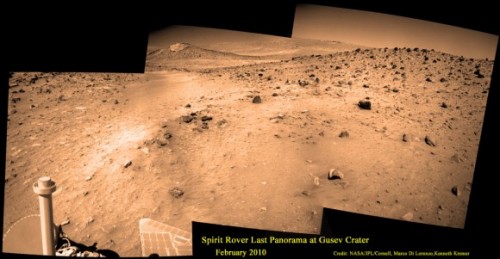January 3 marked ten years since the landing of the Mars rover Spirit, which is no longer active, and at the end of the month it will be ten years since Opportunity continues to provide scientific knowledge at the same time as its sophisticated successor Curiosity Spirit and its counterpart Opportunity were planned to operate for three months. Spirit has been operating for over six years and Opportunity is still performing science missions.

January 3 marked the tenth anniversary of the landing of the Spirit robotic rover on Mars on January 3, 2004.
Spirit was one of a pair of vehicles on the Mars Exploration Rovers mission. Opportunity landed on the opposite side of the Red Planet three weeks later. The goal was to find the remains of water that could allow the development of bacteria on Mars if they ever existed.
Together, the two long-lived golf cart-sized vehicles provided evidence that early Mars was hot and wet billions of years ago. An important finding in the search for environments friendly to extraterrestrial life.
Exactly a decade ago, the robot survived the heating while descending in the Martian atmosphere for six minutes and released airbags that stopped its fall. In the end he landed in the Gosev Crater, a crater with a diameter of about 150 kilometers. The process, which Opportunity also went through, is known as the "six minutes of fear".
The three landing legs opened and the Spirit began a journey that was supposed to last 90 Martian days (about 93 Earth days). He survived for over six years. It was estimated that the accumulation of dust on the solar collectors would not allow them to generate enough electricity to operate the robotic vehicles.
No one expected that Martian winds would occasionally clean the solar panels and give them extra life or that the electronic components would continue to function unexpectedly.
In its six years of operation, the Spirit traveled a distance of 7.73 km, not much, but 12 times the planned mission and also transmitted 124 images. After landing on the dusty plains, Spirit headed for the Columbia Hills (named after the space shuttle that crashed in 2003), which are about 3 kilometers away and finally became the first permanent mountain climber, when he climbed Hasband Hill (named after Rick Husband, mission commander STS-107 - the mission the last of Columbia), and finally he found evidence of liquid water in the area known as the Hilary Emergence.
The vehicle was not designed to climb mountains, but in the end it was able to climb steep slopes at an angle of up to 30 degrees. Spirit was equipped with a Rock Abrasion Tool (RAT) built by Honeywell Robotics. Spirit scraped the surface of 15 rocks with RAT and cleaned 92 rocks with a special brush in preparation for research with a spectrometer and imaging microscope.
Eventually Spirit drove back down and made even greater scientific discoveries in the area known as the "Home Plate".
Stephen Skivers, the chief scientist and director of the Mars Rover Project on behalf of Cornell University explains: "At the Opportunity landing site, we discovered evidence that early Mars contained underground water that occasionally reached the surface and evaporated, leaving salt behind. It was a watery environment but it was very different from the one Spirit discovered."

Towards the end of 2010, Spirit drove towards a pair of rocks and reeds known as "Von Braun" and "Goddard", but a few hundred meters before the destination the vehicle was stopped when it got stuck in a sand trap.
"When Opportunity reached the edge of Endeavor Crater he started a new mission. We discovered gypsum deposits and rich concentrations of clay-based minerals. These minerals tell us about a neutral, non-acidic aqueous chemistry more favorable to microbial life, if such ever existed on Mars."
"Thanks to the longevity of these vehicles, we were able to explore four different landing sites for the price of two."
Meanwhile, the new and more sophisticated rover Curiosity marks 500 sols on Mars and is speeding toward Mount Sharp inside Gale Crater, a crater similar in size to Gusev Crater. As we know, two spacecraft are also making their way to Mars - NASA's Mayvan and the Indian MOM.
For the news in Universe Today
More of the topic in Hayadan:
- The end of the road for the Mars Spirit vehicle
- Spirit may have discovered evidence of ancient hot springs on Mars

2 תגובות
Nice..what we are not told is about the discovery of remains of an ancient civilization on the surface of Mars, the retouching department of NASA is working overtime to hide the truth but luckily in our time it is very difficult, the Internet is full of NASA materials that prove it above all Undoubtedly, anyone with an eye on their head knows this.